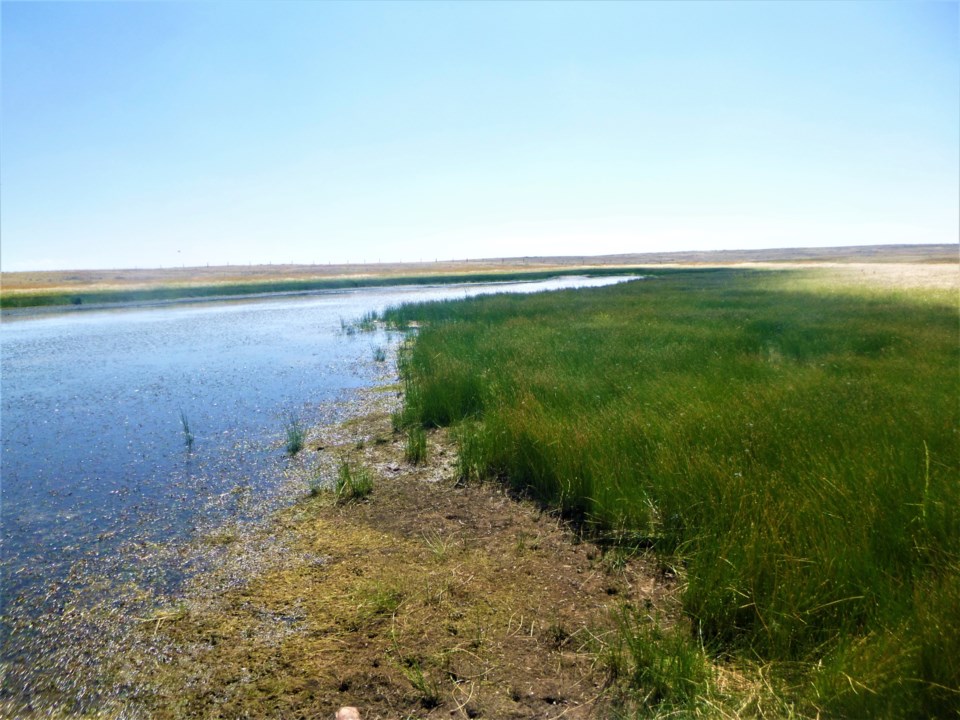The protection of native grasslands is a priority in Saskatchewan, and the Nature Conservancy of Canada (NCC) is sharing some encouraging news this summer.
The not-for-profit, charitable land trust has announced three new conservation projects. Two sites, totalling 1,092 hectares (2,698 acres) are located in the Milk River Basin Natural Area of the southwest corner of the province. These grassland and wetland properties are situated within a designated Important Bird and Biodiversity Area (IBA). This natural area is home to many species, including 20 that are designated under Canada’s Species at Risk Act (SARA), such as the endangered greater-sage grouse. Historically, one-third of Canada’s greater-sage grouse population was found in this area. The properties also provide habitat for ferruginous hawk, which is listed as threatened under SARA. Fifty known ferruginous hawk sites are found in this IBA, one of which is located on one of the properties.
The other site is located along a river valley northwest of Regina. It is 578 hectares (1,429 acres) and features a large block of native grassland and other habitats. Ten species within a 20-kilometre radius of the property are listed under SARA including: burrowing owl (endangered), Baird’s sparrow (special concern), Sprague’s pipit (threatened), loggerhead shrike (threatened) and northern leopard frog (special concern).
All three projects are the result of visionary landowners who aren’t looking for any recognition and who wish to remain anonymous. To respect their privacy, the exact locations of the properties are not being released. The conservation agreements with these property owners ensure the properties will not be developed, subdivided, drained or harvested. However, they will continue to be used for cattle grazing.
These conservation projects were supported by the Government of Canada, through the Natural Areas Conservation Program; the Government of Saskatchewan, through the Fish and Wildlife Development Fund; the U.S. Fish and Wildlife Service, through the North American Wetlands Conservation Act, along with other private contributors.
Quotes
“Grasslands and the wetlands they contain benefit migratory birds and imperiled species and are critical for our own livelihoods, those of our ranching partners who contribute to grassland health and for our children and grandchildren. Now, less than 20 per cent of native grasslands remain in Saskatchewan. Conserving grasslands is one of the most important things we can do for our province”. - Jennifer McKillop, Vice-president for the Nature Conservancy of Canada in Saskatchewan.
“Nature is central to Canadian identity, but recent scientific reports have shown that our biodiversity is under threat.With the help of partners like the Nature Conservancy of Canada and generous donors, our government is making progress towards doubling the amount of protected nature across Canada. By taking the initiative now to protect grassland and wetland habitat in Saskatchewan, we’re ensuring our kids and grandkids can connect to nature and experience its wonder.” - Catherine McKenna, Minister of Environment and Climate Change
Facts
· People can support NCC’s work in Saskatchewan to protect endangered grasslands, wetlands and the at-risk species that live here. Visit conservegrasslands.ca.
· The two properties in southwest Saskatchewan expand the Nature Conservancy of Canada’s protected areas in the region to 14,807 hectares (36,590 acres).
· Priority species found along the river valley northwest of Regina include burrowing owl, loggerhead shrike, bobolink, Sprague’s pipit, Baird’s sparrow, barn swallow and western grebe. Waterfowl commonly found within the area include northern pintail, Blue-winged teal and mallard.
Learn more
The Nature Conservancy of Canada (NCC) is the nation's leading not-for-profit, private land conservation organization, working to protect our most important natural areas and the species they sustain. Since 1962, NCC and its partners have helped to protect more than 60,700 hectares (150,000 acres) of ecologically sensitive lands and waters in Saskatchewan. To learn more, visit natureconservancy.ca.
The Government of Canada’s Natural Areas Conservation Program (NACP) was established to accelerate the pace of land conservation across southern Canada. Federal funds invested in the public-private partnership program were matched by contributions raised by NCC and its partners. Habitat conserved under the NACP will enhance natural corridors and other protected areas.
The NACP concluded March 31, 2019. It has been replaced by Canada’s Natural Heritage Conservation Program (NHCP), which will continue to support new protected and conserved areas by securing private lands and private interests in lands.



